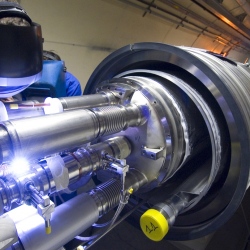
In the mid-1930s, physicists thought they knew all the subatomic particles of nature – the proton, neutron, and electron of the atom. However, in 1936 the muon was discovered – a new particle having such surprising properties that Nobel laureate I.I. Rabi quipped, "who ordered that?" when informed of the discovery. Evidence that a new light boson may exist has recently been published. Such a boson is not part of the Standard Model (SM) of particle physics. If its existence is confirmed, physicists will confront another "who ordered that?" moment.
The unexpected new light boson, named the E(38) boson for now, is awaiting additional independent verification at present. If so verified, it was discovered at the Nuclotron superconducting particle accelerator at the Joint Institute for Nuclear Research in Dubna, near Moscow. The E(38) appears to have a mass of about 2.5 percent of a proton (38 MeV vs 938 MeV) – lighter than any elementary particle other than neutrinos or electron/positrons. This energy range has been investigated in countless experiments over at least six decades, with few if any previous hints of the existence of a light particle.
The suggestion has been made that the E(38) may not couple electromagnetically. If the E(38) were a stable particle it would be a prime candidate for making up part or all of the cosmological dark matter. However, the E(38) boson is unstable, with a extremely short half-life, so the identity of dark matter is still one of nature’s well-kept secrets.
